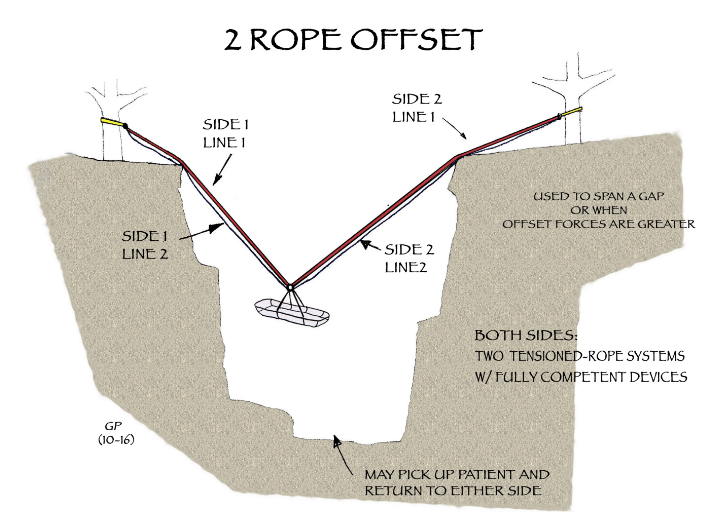Class 5 Litter Handling: Techniques for Safe and Effective Rescue
Class 5 litter handling is a critical component of technical rescue operations, focusing on the safe and effective transport of an injured person on a stretcher. These techniques ensure the patient is properly secured while enabling the litter and rescuer to navigate complex terrain, such as roofs, overhangs, or hazardous areas.
This guide outlines the essential strategies and systems used in Class 5 litter handling, including offsets, guiding lines, skate blocks, and two-rope offset systems.
General Considerations for Class 5 Litter Handling
When maneuvering a litter past obstacles like roofs or overhangs:
- Positioning the Tender:
- The litter tender should position their legs through or above the spiders (litter suspension rigging) to hold the litter away from the wall or obstruction.
- Allow the litter to swing gently under the roof before repositioning themselves under the litter.
- Securing the Patient:
- Ensure the patient is properly positioned and tightly secured to prevent movement during transport.
- Double-check all rigging points on the litter to ensure stability and safety.
Key Techniques for Class 5 Litter Evacuations
1. Offsets
Offsets allow the rescuer to redirect the litter and patient away from obstructions like walls or rock faces. These are ideal when the litter handler cannot physically move the litter due to the terrain.
How to Use Offsets:
- Purpose: To clear obstacles or span gaps where direct movement is restricted.
- Execution:
- Use a mechanical advantage system to create the necessary offset.
- Adjust the load only enough to avoid the obstruction or complete the gap traverse.
2. Guiding Lines
Guiding lines combine lowering and tension systems to guide the litter out of hazard zones and into safe landing areas. These systems are particularly useful for:
- Controlling descent in hazardous terrain.
- Preventing pendulum swings in areas with uneven terrain or exposed drops.
Key Components:
- Tension System: Keeps the litter on a controlled path.
- Mechanical Advantage: Used to tension the guiding line, ensuring stability and precision.
3. Skate Blocks
A skate block is a variation of the guiding line system, commonly used in scenarios like:
- Towers or high-rise structures.
- Cliff sides with pre-determined landing zones.
Applications:
- Raises and Lowers: Can be used in both raising and lowering operations.
- Terrain Suitability: Best for environments where a direct path to the landing zone is required.
Advanced Systems for Class 5 Litter Handling
1. Deflection Lines
Deflection lines are used to offset the litter from walls or rock faces. For larger offsets or more complex terrain, two deflection lines may be required.
Considerations for Using Deflection Lines:
- Single vs. Double Lines:
- For short gaps, one deflection line may suffice.
- For longer gaps or higher risk scenarios, use two lines for redundancy.
- Pendulum Risk: Evaluate the potential for injury if a line fails, and always use a belay line when necessary.
2. Two-Rope Offset System
The two-rope offset system offers a robust alternative to deflection lines or Tyrolean traverses when spanning large gaps.
How It Works:
- Uses two TTRS (Two-Tensioned Rope Systems) or two main/belay systems.
- While one system lowers, the other raises, allowing precise control of the litter and patient.
Advantages:
- Ideal for evacuating large groups or moving multiple patients.
- Provides greater control and redundancy compared to single-line systems.
Safety Tips for Class 5 Litter Handling
- Double-Check Rigging: Ensure all connections, knots, and anchors are secure before beginning the operation.
- Monitor the Patient’s Position: Regularly assess the patient’s comfort and stability during the evacuation.
- Plan for Redundancy: Always incorporate backup systems, such as belay lines or secondary anchors, to minimize risks.
- Assess the Terrain: Consider edge transitions, friction points, and environmental hazards before deploying the system.
Conclusion
Class 5 litter handling requires a combination of advanced rigging techniques, strategic planning, and precise execution. By mastering systems like offsets, guiding lines, skate blocks, and two-rope offsets, rescuers can navigate complex terrain safely and efficiently while ensuring the patient’s well-being.
Proper preparation, training, and adherence to safety protocols are critical to the success of any rescue operation.
Peace on your days,
Lance
Explore More at Rigging Lab Academy:
- Guiding Line Techniques for Rescue
- Mechanical Advantage Systems Explained
- Advanced Litter Handling Strategies
Peace on your Days
Lance











